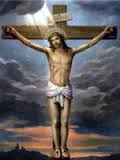RESURRECTED LIKE NO OTHER
Many have no fear for their own death but according to the National Institute of Mental Health, 68% of people fear death. From a purely human viewpoint, why would anyone look forward to the cessation of their life? We know those in the military, when presented with a dangerous situation, will risk their lives for others. Confronted with a situation that threatens our close loved ones, we, too, will risk our lives for them. However, in either case (military or loved ones) these potential sacrifices are not planned. Jesus’ sacrifice had long been planned. He gives us hope in the face of death. That hope was made clear when Jesus rose from the dead. His death and resurrection conquered death for those who place their faith in Him. We can be assured of eternal life- even beyond this physical life- because of Jesus.
Read Matthew 28:1-7
Jesus is alive and we can live forever!! The Jewish Sabbath day had ended at sunset on Saturday and we learn that the stone had been removed from the tomb’s entrance. Mary Magdalene and “the other Mary” (who was the mother of James and Joseph Matt. 27:56) went to the tomb with spices to prepare Jesus’ body for burial. There are reports that there was no time before the start of the Sabbath after Jesus was removed from the cross to apply such spices to His body. So when the women, who had supported Jesus during His ministry, arrived at the tomb they found the tomb empty. They had fully expected to find His corpse and they had major concerns on how they would remove the stone blocking the tomb’s entrance (Mark 16:3). Even while planning to honor Jesus by applying the spices, they had to be feeling a sense of hopelessness, defeat or confusion. Without question, the stone over the tomb was never a problem for the women as the angel had moved the stone so the women could enter the tomb. However, in their minds, they still faced the tragic situation of facing Jesus’ corpse- until the angel spoke. (It is clear that the angel was described as a “He”. Of course, we really don’t know what that means for an ”angel”.)
It should be understood that the stone was not rolled aside so Jesus could get out but so others could get in and see that Jesus had indeed risen from the dead, just as He had promised. The women were greeted by a sight very different from anything they had expected. Either just before or at the time of their arrival at the tomb, “there was a violent earthquake” (v.2)! An angel came down out of heaven, rolled the stone away from the entrance and in triumph, sat on the stone. The angel’s dazzling appearance was a chock to the Roman guards, who trembled and fell unconscious. The angel gave the women a message of comfort- “He is not here!” His former burial place was now empty, and they could easily verify this fact for themselves. His resurrection had been a bodily one. Besides telling the women that Jesus had risen, the angel sent the women on a mission. They were to find Jesus’ disciples and tell them the wonderful news of the resurrection. They were also to tell the disciples that Jesus would precede them to Galilee. When the disciples returned to Galilee, they would find Him there already.
The angel, who announced the good news of the resurrection to the women, gave them four messages: 1) Do not be afraid! The reality of the resurrection brings joy, not fear. When we are afraid, remember the empty tomb. 2) He isn’t here. Jesus is not dead and is not to be looked for among the dead. He is alive, with His people. 3) Come see! The women could check the evidence for themselves. The tomb was empty then, and it is empty today. The resurrection is a historical fact. 4) Go quickly and tell! They were to spread the joy of the resurrection. Jesus’ resurrection is the key to the Christian faith.
Why is this the key to Christian faith? (It shows that the Living Christ is the ruler of God’s eternal Kingdom, not a false prophet or imposter. We can be certain that an earthly death is not the end. There is future life!)
Read Matthew 28:8-10
Notice the unusual use of the words “fear and great joy” together, but the presence of both is understandable. The women had just experienced an earthquake, had seen a radiant angel, and had heard of Jesus’ resurrection. Who among us would not have had some fear? And at the same time, the joy of knowing that Jesus had overcome death and was ready to meet them in Galilee filled their hearts with overwhelming gladness and joy. The women quickly left the tomb to carry out the angel’s instructions. So fear mingled with the joy they felt as they ran to tell the eleven remaining disciples the news of the resurrection. The empty tomb by itself did not prove the resurrection. But now the women were about to witness the real proof that Jesus had risen. Jesus met them on their way and He spoke to the women. The meeting was not merely a vision. The Mary’s were able to grasp Jesus’ feet in an act of worship. He was the Jesus they remembered. But now they recognized Him as deserving the worship belonging to God alone. They may have felt like breaking out in a happy dance or at least sing “Oh Happy Day”.
Jesus repeated the instructions the angel had given the women (28:7). There was one important change, however. He called His disciples “my brothers” (v. 10). They had failed Him completely in His time of greatest trial, but Jesus forgave them and looked ahead to what they would be as they served Him in the future. Jesus told the women to pass a message to the disciples. He said that He would meet them in Galilee, as He had previously told them (Mark 14:28). The disciples were afraid of the religious leaders and they stayed hidden behind locked doors in Jerusalem (John 20:19). Jesus did not unlock the door. He just appeared to them in the flesh. So Jesus met them first right there (Luke 24:36) and then later in Galilee (John 21).
Matthew goes to tell of that meeting in Galilee also (28:16-20), but does not mention the initial Jerusalem meeting. Why do you think that Matthew did not mention the Jerusalem meeting? (It could be that Matthew was not wanting tell that he and others were afraid to go to Galilee! Maybe he thought it was not that important to share.)
Afterwards, the disciples became eyewitnesses of the resurrected Lord. Paul wrote, “He (Jesus) appeared to over 500 at one time… Then He appeared to James, then to all the apostles. Last of all He also appeared to me.” (1 Cor. 15:6-8). All of these passed their witness on to others, who told others, until someone told us. So our responsibility is to pass it on to as many as we can. Because Jesus rose from the dead and is alive today, we can not only know the story, we can also experience the eternal life with Him that God desires for each of us. Jesus resurrection is completely unique. No other “leader” of their religion rose from the dead; Buddha did not; Muhammad did not; Confucius did not! As our lesson title indicates- Resurrected Like No Other!
REVELATION: A DEEPER LOOK INTO THE MEANING

THE BOOK OF REVELATIONS IS FILLED WITH SYMBOLISM AND PHRASES THAT ARE NOT EASY TO UNDERSTAND. THERE ARE A LOT OF GOOD BOOKS ON REVELATION AND HEAVEN. THIS IS JUST ONE FOR YOU READING TIME.





